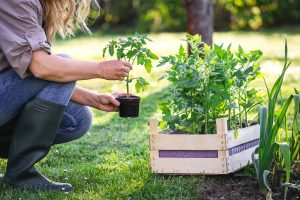The weather is right to get busy in the garden
By Nick Frillman University of Illinois Extension Services — May 12, 2023
Gardeners get very excited to plant warm-season plants around Mother’s Day Weekend, however, tomato and peppers will perform best if you delay this planting until the end of May.
As the weather warms, satisfy the garden itch by preparing the ground for planting, creating a garden plan, and planting a crop of cool-season vegetables on Mother’s Day weekend.
Preparing the ground
Clear away garden debris
The first step to preparing your garden for summer planting is to clear away any dead plants or debris. Although dead material provides a refuge for overwintering insects, it is a breeding ground for pests and disease when the growing season begins. By May, nighttime temperatures are around 50 degrees and overwintering insects no longer need shelter, so it is safe to remove the debris. Clearing unnecessary debris from spring garden beds provides air and light penetration to the soil which warms the soil. Warming soil means higher microbial activity, and potentially, quicker growth, once plants are in the ground.
Improve soil health
Growing healthy, happy garden plants depends entirely on the state of the garden soil. Therefore, it is a good idea to check for soil compaction. If garden soils are compacted, nutrient availability and water retention can be jeopardized, leading to slow-growing or stunted plants. Well-structured soil will crumble easily by hand. If it does not, loosen the soil by tilling or with a garden fork. Add organic matter (compost) to compacted soils to improve soil structure, lower soil compaction, and improve soil fertility. Illinois Extension recommends additions of high-quality compost to annual vegetable beds on a yearly basis. This practice is also recommended for annual flower beds and perennial plantings.
Plan the garden
Well-prepared garden soil needs a garden plan to ensure planting intervals and spacing produce healthy plants. When planning, consider the plant’s growth requirements, crop yield, and susceptibility to pests and diseases. It can be tempting to reduce plant spacing to increase your growing capacity, but crowding plants can reduce crop yield and increase disease problems. For larger spaces, saved for long-season crops (tomatoes) that fill-in late in the season, consider planting a few short-season plants (green onions) and remove them as the season progresses. This interplanting is a great combination because the plant root systems do not compete; tomato roots are deep and green onion roots are shallow.
A garden plan is a history book of your garden. An accurate record of plantings allows you to rotate crops which leads to healthier plant growth. By replenishing soil nutrients and reducing the prevalence of stressful growing conditions, crop rotation reduces the likelihood of pest or disease problems. Heavy feeders (tomatoes) deplete soil nitrogen, potassium, and phosphorus. Growing them in the same location (in nutrient-deprived soil) will stress the plant.
According to the University of Minnesota Extension, the ideal crop rotation is a minimum of three years, four years is ideal. To grow the healthiest plants, like tomatoes, rotate the plants through four planting locations and replenish the soil with a follow-up planting of beans or peas—both are nitrogen suppliers. If space is limited, consider a tomato-free year and share a neighbor’s harvest. How ever you rotate your garden beds, this particular bed should not see another tomato plant until 2026.
Another aspect to consider when planning the garden out is companion planting. Companion planting involves planting different crops together for mutual benefit, such as repelling pests or absorbing different nutrients. For example, marigolds planted with vegetables can help repel pests such as aphids, cabbage maggots and squash buds, according to Cornell Extension.
Plant cool-season vegetables
Now, everyone gets very excited to plant warm-season plants around Mother’s Day Weekend, however, tomato and peppers will perform best if you delay this planting until the end of May. Instead, celebrate time in the garden with Mom by planting cool-season vegetables that thrive in early May conditions of Central Illinois: Broccoli, cabbage, lettuce, peas, radishes, spinach, Swiss chard, turnips, and arugula, are great garden additions in early to mid-May. Transplants of things like broccoli and cabbage are available at most local garden centers if direct seeding is undesirable.
A gardeners success comes with careful planning, cleanliness, and good timing. Each piece is valuable, and all pieces are needed to complete the puzzle of growing a healthy garden. Put the puzzle together using this and other research-based information from Illinois Extension. We are here to help optimize your gardening practices leading to a fruitful garden season.
Nick Frillman is the local food systems and small farms educator for serving Livingston, McLean and Woodford counties.







